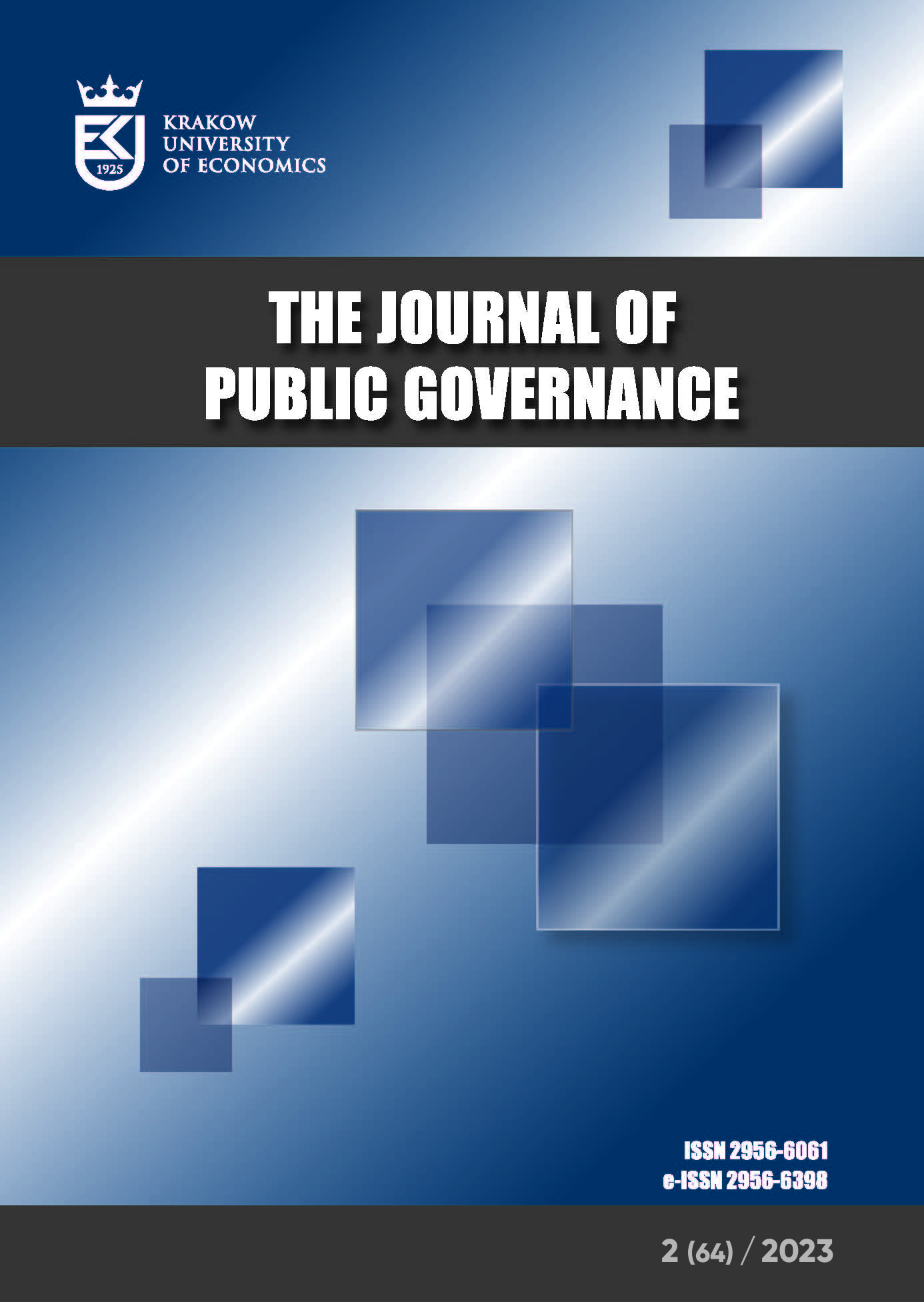The Specificity of Urban Sprawl in Poland: The Spatial, Social, and Economic Perspectives
DOI:
https://doi.org/10.15678/ZP.2021.55.1.05Keywords:
urban sprawl, metropolitan area, spatial planning in Poland, urban development policyAbstract
Objectives: The purpose of this article is to show and highlight the selected development-related trends of urban areas in Poland, with particular emphasis put on the phenomena that constitute urban sprawl, and taking into consideration historical aspects of the urban sprawl.
Research Design & Methods: The object of the study was Poland. The important base of the analysis was the historical evolution of the urban sprawl in Poland. The main research method is a comparative analysis based on historical examples in order to show the “roots” of the development processes of the urban sprawl in Poland as well as their characteristic features.
Findings: As a result of the research, the authors have determined that the Polish urban sprawl is specific and results from historical changes, the mentality of Polish people, economic processes, and legal conditions (too liberal laws on spatial planning).
Contribution / Value Added: This research adds to knowledge about the circumstances of the phenomenon of the urban sprawl in Poland, its evolution, and – above all – the degree of the individualisation of the causes and consequences of the Polish urban sprawl, which will allow decision-makers to adopt appropriate tools to support local development.
Implications / Recommendations: Polish urban sprawl is specific due to the high degree of suburban urban chaos (disorganised, spontaneous development), which has negative economic, social, and environmental consequences. In connection with the consequences of urban sprawl, action should be two-fold: on the one hand, it is about organising stretched suburban areas, giving them new spatial, social, cultural, and economic values. Here, an important role is played by spatial and social planning; the search for axes crystallising the organisation of space, i.e. places around which development could concentrate, creating more focused and ordered areas. There is also a need for centres of social concentration that could create centres of social life. This role could be played by cultural institutions (e.g. libraries), educational institutions, or religious institutions. On the other hand, it is necessary to create conditions for a ‘return to the cities’ for those whose life situation has changed, e.g. if their children are of legal age and independent, or who grew up in the suburbs. The latter is very complex. It would be difficult to identify existing cities that have ‘recovered’ their inhabitants from suburban areas on a large scale. Infrastructural preparation is needed, i.e. some sort of the rebuilding of cities, especially their centres. What is needed is the development of services and recreational spaces as well as the creation of new opportunities and possibilities.
Article classification: research article
JEL classification: R1-1, R5-2, R5-8
Downloads
References
Böhm, A. (2021). Krajobraz w czasach populizmu i postprawdy. Wydawnictwo Uniwersytetu Warszawskiego.
CBOS (2010). Polacy o architekturze. Komunikat z badań BS/134/2010, available at: http://www.cbos.pl/SPISKOM.POL/2010/K_134_10.PDF (accessed: 19.06.2019).
Encyklopedia Historii Gospodarczej Polski do roku 1945, Vol. 1 (1981). Wiedza Powszechna.
Frąckowiak, M. (2010). Niedorozwój mieszkalnictwa w Polsce i jego konsekwencje. Ruch Prawniczy, Ekonomiczny i Socjologiczny, LXXII(1), 115–135.
Howard, E. (1902) Garden Cities of To-morrow (II wyd. Tomorrow: A Peaceful Path to Real Reform). Swan Sonnenschein & Co.
Jedlicki, J. (1988). Jakiej cywilizacji Polacy potrzebują? Państwowe Wydawnictwo Naukowe.
Karwińska, A., Böhm, A., & Kudłacz, M. (2018). The phenomenon of urban sprawl in modern Poland: Causes, effects and remedies. Public Governance, 3(45), 26–43.
Karwińska, A., & Brzosko-Sermak, A. (2014). Miasto dobrze funkcjonujące. Uniwersytet Ekonomiczny w Krakowie.
Kochanowska, D., & Kochanowski, M. (2000). Polskie miasta w procesie globalizacji. Studia Regionalne i Lokalne, 1(1), 47–53.
Kodym-Kozaczko, G., & Kozaczko, M. (2009). Plan ogólny zabudowania Poznania (1931–1939) na tle europejskiej teorii i praktyki budowy miast. In M. J. Sołtysik & R. Hirsch (Eds.), Modernizm w Europie – modernizm w Gdyni. Architektura lat międzywojennych i jej ochrona (pp. 105–114). Urząd Miasta w Gdyni, Wydział Architektury Politechniki Gdańskiej.
Kowalewski, A. (2005). Przez metropolie do dobrobytu? Studia Regionalne i Lokalne, 1(19), 15–35.
Kubicki, P. (2011). Nowi mieszczanie w nowej Polsce. Raport. Instytut Obywatelski.
Kudłacz, M. (2016). Dysfunkcje amorficznego rozrostu osadnictwa w Polsce. Studia Ekonomiczne – Zeszyty Naukowe Uniwersytetu Ekonomicznego w Katowicach, 279, 245–257.
Kudłacz, M., & Hausner, J. (2017). Funkcjonowanie metropolii w Polsce. Gospodarka, przestrzeń, społeczeństwo. CeDeWu.
Lisowski, A., & Grochowski, M. (2008). Procesy suburbanizacji. Uwarunkowania, formy i konsekwencje. In K. Saganowski, M. Zagrzejewska-Fiedorowicz, & P. Żuber (Eds.), Ekspertyzy do Koncepcji Zagospodarowania Przestrzennego Kraju, Vol 1. (pp. 221–274). Ministerstwo Rozwoju Regionalnego.
Mokrzycki, E. (2000). Jaką mamy demokrację? In H. Domański, A. Ostrowska, & A, Rychard (Eds.), Jak żyją Polacy? (pp. 19–32). IFiS PAN.
Nowak, S. (1979). System wartości społeczeństwa polskiego. Studia Socjologiczne, 4(75), 155–172.
Paszkowski, Z., Węcławowicz-Bilska, E., & Schneider-Skalska, G. (2014). Tendencje rozwoju polskiej urbanizacji. In J. Sepioł (Ed.), Przestrzeń życia Polaków (pp. 15–36). SARP.
Podedworna, H. (2006). Przemiany zbiorowości wiejskich. In J. Wasilewski (Ed.), Współczesne społeczeństwo polskie. Dynamika zmian (pp. 199–228). Wydawnictwo Naukowe Scholar.
Radziejowski, J. (2002). Zrównoważone użytkowanie przestrzeni – wyzwanie dla urbanistów XXI wieku. In K. Kamieniecki (Ed.), Raport. Miasto za miastem (pp. 20–22). Instytut na Rzecz Ekorozwoju. Raport o Ekonomicznych Stratach i Społecznych Kosztach Niekontrolowanej Urbanizacji w Polsce (2013). Collective work by Fundacja Rozwoju Demokracji Lokalnej, IGiPZ PAN.
Raport wprowadzający Ministerstwa Rozwoju Regionalnego na potrzeby przeglądu OECD krajowej polityki miejskiej. Part I. Diagnoza stanu polskich miast. (2010) Ministerstwo Rozwoju Regionalnego. Departament Koordynacji Polityki Strukturalnej.
Samsonowicz, H. (1970). Życie miasta średniowiecznego. Państwowe Wydawnictwo Naukowe.
Wnuk-Lipiński, E., & Bukowska, X. (2008). Stosunek Polaków do własnego państwa. Nauka, 2, 7–28.
Wycichowska, B. (2012). Zagrożona przyszłość miasta. Przykład Łodzi. Architektura. Czasopismo Techniczne, 1, 433–441.
Zachariasz, I. (2013). Prawne uwarunkowania efektywności planów zagospodarowania przestrzennego w Polsce. Public Governance, 1(23), 5–16.
Ziółkowski, M. (2000). Przemiany interesów i wartości społeczeństwa polskiego. Teorie, tendencje, interpretacje. Fundacja Humaniora.
Żarnowski, J. (1999). Polska 1918–1939. Praca, technika, społeczeństwo. Książka i Wiedza.
Downloads
Published
How to Cite
Issue
Section
License
Open Access, licence: CC-BY 4.0




